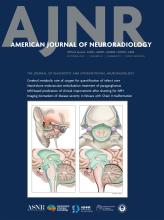This article requires a subscription to view the full text. If you have a subscription you may use the login form below to view the article. Access to this article can also be purchased.
Abstract
BACKGROUND AND PURPOSE: The susceptibility vessel sign, a hypointense signal on MR T2-weighted gradient-recalled echo images, is associated with erythrocyte-predominant thrombi, which are often present in cardioembolism. In contrast, cancer-associated hypercoagulability (CAH)-related stroke, which is presumably caused by fibrin-predominant thrombi, is associated with the absence of the susceptibility vessel sign. We hypothesized that the prevalence of the susceptibility vessel sign may be helpful in distinguishing CAH-related stroke from cardioembolism. This study attempted to validate this hypothesis and investigated the usefulness of the susceptibility vessel sign in differentiating CAH-related stroke from cardioembolism.
MATERIALS AND METHODS: We retrospectively studied patients with both CAH-related stroke (CAH group) and cardioembolism (cardioembolism group) who had major cerebral artery occlusion on MRA that was performed within 6 hours of stroke onset. All patients visited our department from 2015 to 2021. CAH-related stroke was defined as the following: 1) complication of active cancer, 2) pretreatment D-dimer value of >3 μg/mL, 3) multiple vascular territory infarctions, and 4) lack of any other specifically identified causes of stroke. We compared susceptibility vessel sign positivity rates within each group. Multivariable logistic regression analysis was used to assess the association between the absence of the susceptibility vessel sign and CAH-related stroke.
RESULTS: Of 691 patients with CAH-related stroke or cardioembolism, major cerebral artery occlusion was observed in 10 patients in the CAH group and 198 patients in the cardioembolism group. The absence of the susceptibility vessel sign was identified in 55 of 208 patients and was significantly more frequent in the CAH group versus the cardioembolism group (90% versus 24%, P < .05). For predicting CAH-related stroke, the absence of the susceptibility vessel sign demonstrated a sensitivity of 90% (95% CI, 59%–99%), specificity of 78% (95% CI, 71%–83%), a positive predictive value of 18% (95% CI, 10–31), a negative predictive value of 99% (95% CI, 96%–99%), and a likelihood ratio of 4.06. Multivariable logistic regression analysis revealed that the absence of the susceptibility vessel sign was independently associated with CAH-related stroke (OR, 43; 95% CI, 6.8–863; P < .01).
CONCLUSIONS: The absence of the susceptibility vessel sign was more frequent in CAH-related stroke than in cardioembolism. These findings could potentially be helpful for clinical management and differentiating cardioembolism and CAH-related stroke.
ABBREVIATIONS:
- CAH
- cancer-associated hypercoagulability
- CE
- cardioembolism
- GRE
- gradient-recalled echo
- SVS
- susceptibility vessel sign
- © 2024 by American Journal of Neuroradiology












